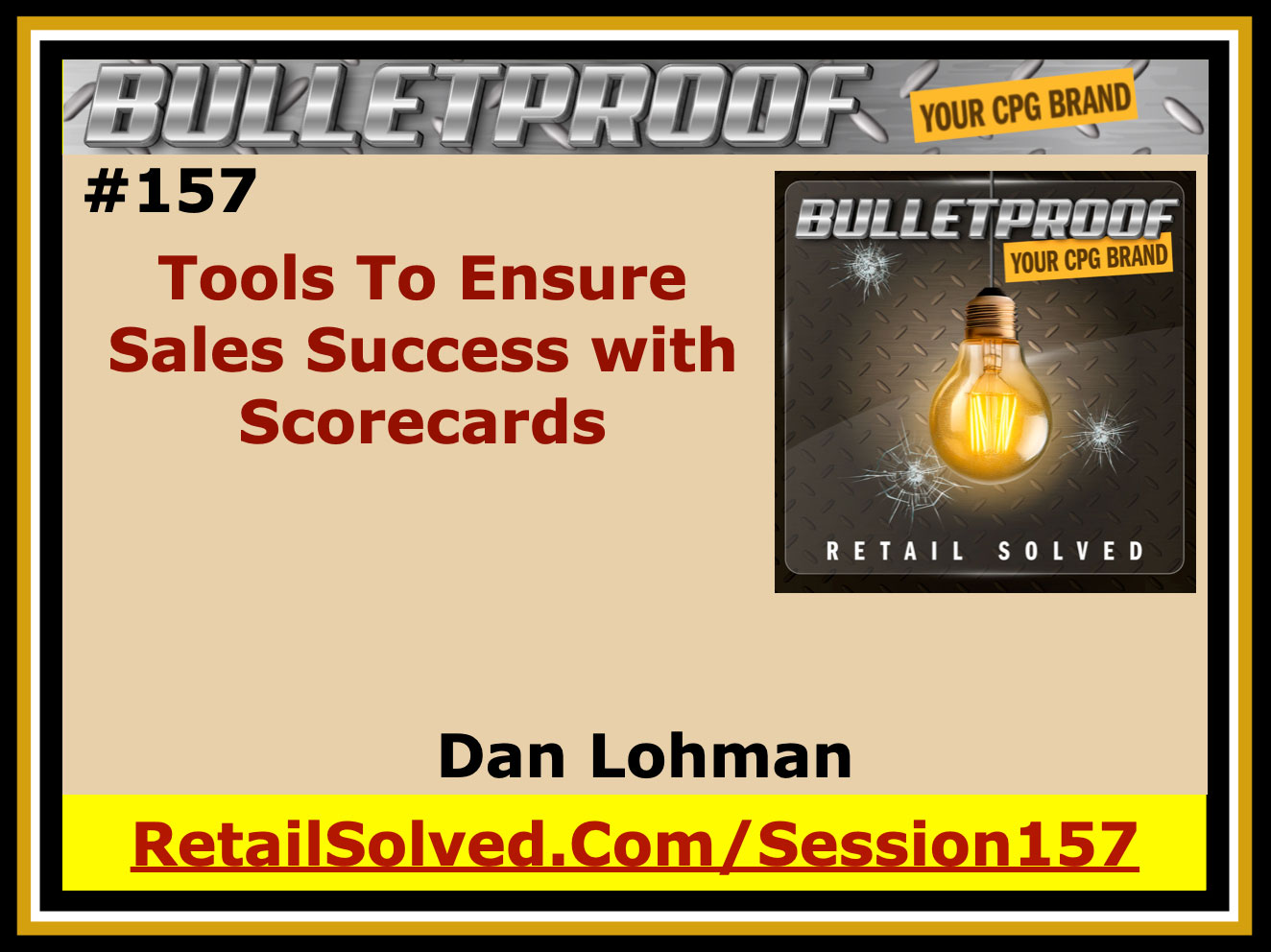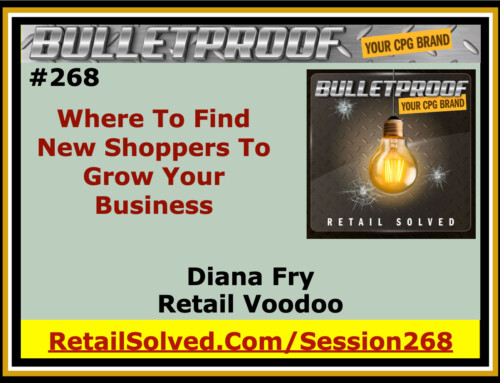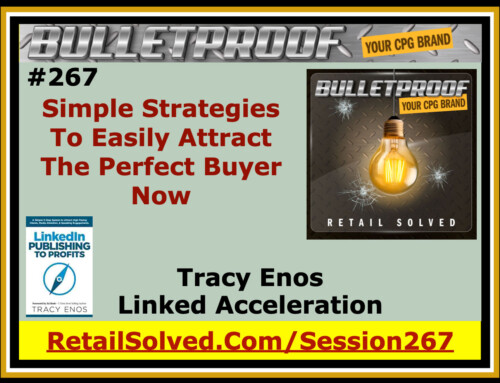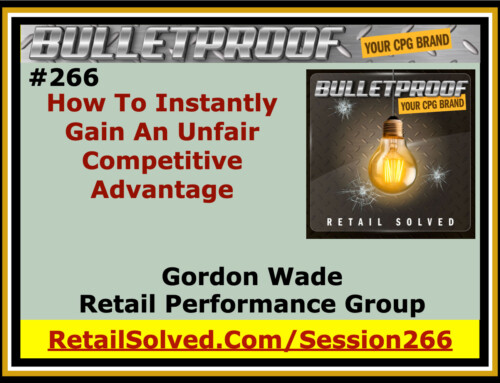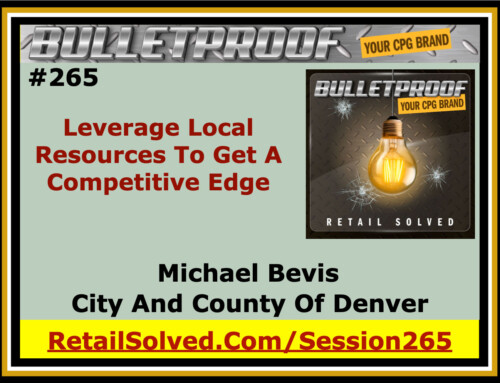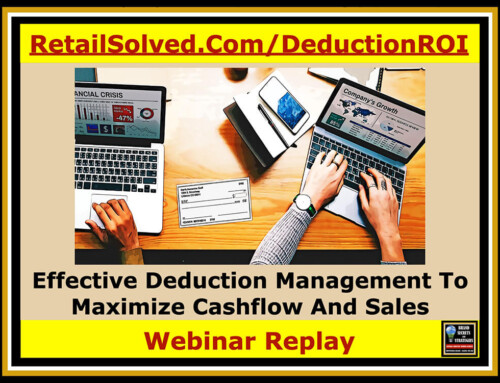Explore the essential tools to ensure sales success and enhance your retail execution with effective scorecards and KPI’s. Scorecards are a project management tool that helps brands track progress, ensure accountability, and execute their go-to-market strategy effectively. They improve communication, align teams, and provide specific instructions to the sales team on how to merchandise and promote products.
Nothing happens until customers buy your products. They can’t buy what they can’t find. Your retail execution needs to be flawless. Scorecards and KPI’s are the best tools to ensure flawless merchandising, distribution, promotions, and sales excellence.
Welcome. Today's story is about the shopper, more specifically about the shopper journey. Let me ask you a question before we get started. How much time do you spend obsessing about your customer's journey? If you've been listening for a while, you know that I obsess about the customer journey all the time. Let's be honest, really honest, if no one buys your product, you don't have a brand. If you don't have sales and retailer A, then you don't have a compelling story to get your product in distribution at retailer B and so on. The point is this, nothing happens until someone buys your products and customers can't buy your products if they can't find them. Sounds pretty simple, but this is something that a lot of brands overlook. You've got to be available wherever your customer shop and getting your product and distribution in the wrong stores where your ideal customer doesn't shop, that's not good for you either.
My point is this, we need to obsess about the customer. We need to back up and put their shoes on and look at our product and what it takes for them to buy our product from their perspective, not our perspective. This is what I'm getting at. A lot of people think about selling their product and they think about it from their perspective, not from the customer. So what I mean by that is if you walk into a store and you have to go on a scavenger hunt to find your product, your customer does, well, a lot of times customers aren't going to do that and you lose out on that sale, and sometimes it's nearly impossible to get that customer back. You've heard me say time and time again, you never get a second chance to disappoint a customer.
So when I talk about the customer journey, I'm talking about actually knowing who your core customer is. This again is something that a lot of brands pay lip service to. My customer, oh, it's a female. Well, not all females are the same. Not all males are the same. My point is that you need to really understand intimately what your customer looks like, not the customer that you hear from a generic focus group, et cetera. How does your customer buy your product? How do they evangelize your product when they take it home and share it with their friends? What is your ideal customer's journey look like? How do they buy the product? When they take it home, how do they share it with their friends? How do they evangelize it? How does your brand become a part of their daily routine?
After all, that's the goal, right? To get customers to come back again and again and again. Well, you can't get that. You can't have that if you don't understand how your customer buys your product. Now, where I'm going with all this is retail execution, flawless retail execution is the fastest path to sales success, and one of the key reasons that most brands fail is because they don't do this right. In other words, a customer goes into the store to find your product and they can't find it. It's priced too high or it's out of stock or it's damaged or something. Remember, your product has your name on it. It is a representation of your brand.
How do you want customers to think about your product when they buy it? Think about it this way. If you were to go out on an interview, you should wear a suit and a tie and look your very best. Even if you're digging ditches, you want to put your best impression forward. You want to show your potential employer that you're serious about the job. Well, the same holds true with your brand. You want each and every customer to know, like and trust your brand, and that begins with how you show up on the shelf and that begins with retail execution, and that's the primary focus of today's podcast.
Today I'm going to share with you a really cool tool that's going to help you be successful, that's going to help you stand out on a crowded shelf, that's going to help you make it easy for your customers to find and buy your product. On a side note, this simple, easy to use solution is something that most brands overlook or pay lip service to. This is the simplest, easiest thing that you can do to be successful and hold people accountable for your success. It's called a scorecard. A scorecard is a tool that you can use for almost anything. For example, project management. If you're going to go into production, when do you need to have the ingredients arrive? When do you need to have the right number of people in place to be able to support your production? How much packaging do you need? Think about all the things that go into making your product.
Well, a scorecard is also a great tool that you can use to help you get your product into retail, especially if you're leveraging a broker or someone else on your behalf to help drive sales.
Download the show notes below
Listen where you get your podcast
Important: Brand Secrets and Strategies has been rebranded to Retail Solved. Please swap all BrandSecretsandStrategies.com URL’s with RetailSolved.com. This is now the Bulletproof Your Brand podcast. Thank you for listening! BRAND SECRETS AND STRATEGIES PODCAST #157 Hello and thank you for joining us today. This is the Brand Secrets and Strategies Podcast #157 Welcome to the Brand Secrets and Strategies podcast where the focus is on empowering brands and raising the bar. I’m your host Dan Lohman. This weekly show is dedicated to getting your brand on the shelf and keeping it there. Get ready to learn actionable insights and strategic solutions to grow your brand and save you valuable time and money. LETS ROLL UP OUR SLEEVES AND GET STARTED! Welcome. Today's story is about the shopper, more specifically about the shopper journey. Let me ask you a question before we get started. How much time do you spend obsessing about your customer's journey? If you've been listening for a while, you know that I obsess about the customer journey all the time. Let's be honest, really honest, if no one buys your product, you don't have a brand. If you don't have sales and retailer A, then you don't have a compelling story to get your product in distribution at retailer B and so on. The point is this, nothing happens until someone buys your products and customers can't buy your products if they can't find them. Sounds pretty simple, but this is something that a lot of brands overlook. You've got to be available wherever your customer shop and getting your product and distribution in the wrong stores where your ideal customer doesn't shop, that's not good for you either. My point is this, we need to obsess about the customer. We need to back up and put their shoes on and look at our product and what it takes for them to buy our product from their perspective, not our perspective. This is what I'm getting at. A lot of people think about selling their product and they think about it from their perspective, not from the customer. So what I mean by that is if you walk into a store and you have to go on a scavenger hunt to find your product, your customer does, well, a lot of times customers aren't going to do that and you lose out on that sale, and sometimes it's nearly impossible to get that customer back. You've heard me say time and time again, you never get a second chance to disappoint a customer. So when I talk about the customer journey, I'm talking about actually knowing who your core customer is. This again is something that a lot of brands pay lip service to. My customer, oh, it's a female. Well, not all females are the same. Not all males are the same. My point is that you need to really understand intimately what your customer looks like, not the customer that you hear from a generic focus group, et cetera. How does your customer buy your product? How do they evangelize your product when they take it home and share it with their friends? What is your ideal customer's journey look like? How do they buy the product? When they take it home, how do they share it with their friends? How do they evangelize it? How does your brand become a part of their daily routine? After all, that's the goal, right? To get customers to come back again and again and again. Well, you can't get that. You can't have that if you don't understand how your customer buys your product. Now, where I'm going with all this is retail execution, flawless retail execution is the fastest path to sales success, and one of the key reasons that most brands fail is because they don't do this right. In other words, a customer goes into the store to find your product and they can't find it. It's priced too high or it's out of stock or it's damaged or something. Remember, your product has your name on it. It is a representation of your brand. How do you want customers to think about your product when they buy it? Think about it this way. If you were to go out on an interview, you should wear a suit and a tie and look your very best. Even if you're digging ditches, you want to put your best impression forward. You want to show your potential employer that you're serious about the job. Well, the same holds true with your brand. You want each and every customer to know, like and trust your brand, and that begins with how you show up on the shelf and that begins with retail execution, and that's the primary focus of today's podcast. Today I'm going to share with you a really cool tool that's going to help you be successful, that's going to help you stand out on a crowded shelf, that's going to help you make it easy for your customers to find and buy your product. On a side note, this simple, easy to use solution is something that most brands overlook or pay lip service to. This is the simplest, easiest thing that you can do to be successful and hold people accountable for your success. It's called a scorecard. A scorecard is a tool that you can use for almost anything. For example, project management. If you're going to go into production, when do you need to have the ingredients arrive? When do you need to have the right number of people in place to be able to support your production? How much packaging do you need? Think about all the things that go into making your product. Well, a scorecard is also a great tool that you can use to help you get your product into retail, especially if you're leveraging a broker or someone else on your behalf to help drive sales. Before I go any further, I want to remind you that there's a free downloadable guide for you at the end of every podcast episode. I always include one easy to download, quick to digest strategy that you can instantly adopt and make your own, one that you can use to grow sustainable sales and compete more effectively with. Remember, this show is about you and it's for you. The goal here is to get your product into more store shelves and into the hands of more shoppers. The focus of today's episode is on scorecards and KPIs. I've just included a robust module for both of these topics in my effective broker management course, my trade marketing essentials course. I'm going to share the highlights with you on this podcast, and by the way, this is something that brands have been reaching out to me and asking me about so I know it's important to you. This is something I've been including in my onsite personal trainings and this is something that's going to help you accomplish the goals and the objectives that you have for the next year and beyond. So let's back way up and start with the basics. One of the key problems that every brand faces is that there's a lot of things to do, so how do you keep track of everything? How do you know that you're working on the right project? How do you keep from being distracted? More importantly, how do you know what your go-to-market strategy is being executed flawlessly at retail? Think about it, the team that wins the game regardless of what sporting event you like is usually the team that executes better, the team that makes fewer mistakes. The same is true in retail. The brand that executes better than the other brands is the brand that's going to succeed nine out of 10 times, literally. This is a simple strategy that I use to push around some of the biggest, most iconic brands on the planet. This is going to help you as well. What I'm getting at, for example, back into my potato chip selling days, I was able to make sure that my displays were always full, that I had the right amount of product in the store to support whatever customers came in, the number of customers. More importantly, my displays always looked nice, and because of this, because I give so much attention to detail, the store manager started trusting me and giving me more opportunities. You've heard me talk maybe about the story where I sold 5,200 bags of chips in one week where the number one competitor, the biggest brand in that category could not get a single display. This is why this is important. If you can execute better than the other brand day in and day out, this is going to dramatically impact your ability to sell, dramatically impact your ability to become a category captain and help you stand out in front of the retailer. So how do you do this? Well, the most effective way to do this is with a scorecard. A scorecard, think of it this way, it's a project management tool. If you're going to bake something, say a cake, well, first of all, you need to make sure you have all the ingredients on hand. Secondly, you need to make sure you have all the right pots and pans. You need to make sure that you've got everything in place so that when you're ready to put the cake, mix the cake together and then put it in the oven, it's going to come out okay. Or how about if you want to make a sandwich, do you have the bread? Do you have the cheese? Do you have whatever you're going to put on your sandwich? The same holds true for getting your product into retail. Do you have the product in stock? Do you have enough to support the retailer? How well do you understand the category and what are the trends that are driving sales within the category? More importantly, how well do you understand the customer that shops a category? Then how is your customer unique? What differentiates your customers from other customers? What makes your customer a better customer to the retailer? In other words, how do they buy your product, and when they buy your product, what are the other products that they putting their shopping basket? These are things that you need to know. These are the things that retailers need to know from you. So before you begin to talk to retailers, you need to make sure you have all those things available and you can put them on your scorecard so you can check them off at each and every retailer appointment to make sure that you're ready ahead of time. So then you get in front of retailer A and you go through your spiel and you tell them why your product is amazing and why your customers are incredibly important to their brand, how your customers are going to help them drive sales. Let's say that they fall in love with your product and they decide to give you an opportunity to get it in distribution. Well, now you need another scorecard to identify when is the product coming in? How are you going to promote it? When are you going to promote it? How deep are you going to drive the promotions, what type of promotions, displays, et cetera? Think about all the things you're going to do to support the product. Then you need to make sure the products available to be shipped on the date that is supposed to be at the store and then you got to get it merchandised on the shelf. Think about all the things that are required to get your product onto a store shelf. They got to make sure it's got the sign in front of it. You've got to make sure that it's merchandised correctly, et cetera. Those are all things that can be included on a scorecard and then when it comes time for your product to be shipped and then put on the store shelf, you can sit back and relax because you know that all that's being taken care of because you planned ahead of time. Here's another example, store demos. In-store demos are one of the best ways to grow your brand. It gives you a unique opportunity to have a one on one conversation with your future customer, but a lot of brands fail when they'd put together store demos and the reason for that is because they don't have their product in stock or worse yet, there's not enough product in stock on the shelf to be able to support the demo. In other words, their brand didn't tell the retailer how much incremental product they needed to bring into the store to be able to support the demo. In addition to that, how well-trained are the people that you're going to use to demonstrate the different products? How good is the signage? How effective are they at stopping people and engaging them in a conversation about your brand? So a scorecard and this example, to support an in-store demo, is going to require that you know how much incremental product you plan to sell during the demonstration. How much incremental product do you need on the shelf or at least in the backroom to be able to support it? Where's the in-store demo going to take place? In what category, what part of the store? There's a big difference between selling your product in the wrong category and selling your product next to where it belongs or next to complimentary categories. Now you need to schedule the people that are going to actually do the demo to show up on time and make sure you got enough people to support every single store you're doing the demo in. Have you taken the time to train each and every one of them? Do they understand what your product is and how your product works and why your product's great? In an earlier podcast, I was talking to Andrew Therrien about exactly this and he shared with me a horror story. A retailer told him about a customer from a different demo company who was actually arguing with their customers, the retailer's customers about how a vegan product couldn't possibly have dairy in it. My point is this, you got to know the products you're selling and you've got to be able to communicate that effectively to the customer. So how well are they trained? Next, do you have the right signage in place? Do you have everything in place set up so that when the person shows up to go to work, they're ready to go? Then, of course, have you coordinated it with the store? Does the store manager know that they're going to have someone in the store on that date and that time to be able to do a demo? These are all things that are critically important to every demo's success. If you run out of stock, you don't have the right friendly people, et cetera, then your demo is going to be a complete failure and a waste of money. This is why a scorecard is so very important. I mentioned a moment ago that included a scorecarding, a more robust scorecarding training in a couple of my courses. One of the key questions that I've been getting asked a lot about is how do you manage your broker more effectively? Well, a scorecard is the ideal tool to help manage effectively your broker. In other words, this is how you give your broker your marching orders. What is your go-to-market strategy? What do you expect from them? For example, if you tell your broker that you want to get in 50% of retailer A stores within the next quarter, well, what does that look like? Which store specifically do they need to get into? Then how do you hold them accountable? Well, if you put that on your scorecard, I need skew number one to be in this store by this date merchandised in this location, et cetera, and then hold a broker accountable for them. This is the greatest way. This is the easiest and best way to make sure, to ensure that your go-to-market strategy is being executed flawlessly. This is also the best way to hold your broker, your agency, and even your internal sales team accountable for results. This is the best and the most effective way to make sure that your customer journey is top of mind, where everything you do. In other words, is there product available where it's supposed to be when it's supposed to be there so that I, the customer can go in and buy it? So let's recap a little bit. Scorecards are a powerful goal-setting tool. You've probably heard that what gets measured gets done. Scorecards map out objectives in bite-sized, manageable chunks that keep you on track and focused. They help you achieve your goals. They can be the difference between success and failure. Scorecards can be modified to track and measure any objective through its completion. Use them on promotions, sales objectives, distribution goals, sales planning, inventory control, and anything that directly impacts your success, including trade marketing, don't forget that one scorecard. Goal setting should be smart, specific, measurable, attainable, realistic and timely. You've got to set people up for success by defining and explaining what success looks like and then help guide them toward whatever your objectives and goals are. Scorecards are an ideal way to improve communication between brand management and senior management, brand sales management, sales teams, brokers, agencies, merchandisers, the store personnel, anyone who touches your product. In other words, this is the easiest way to get everyone in lockstep and focus on your product. You've heard me talk a lot about the importance of a brand story and how that brand story needs to be told in the same voice. In other words, if I share a story with you and you share it with someone else and so on, by the time the story comes back around to me, it's unrecognizable. This is why I developed my free turnkey sales story strategies course. This is at the heart of scorecards. In other words, everyone needs to be in lockstep when it comes to retail execution when it comes to being able to communicate your brand story to the end consumer and a scorecard is one of the best ways that I know of to ensure that everyone's on the same page. Here's a quick pro-tip for you. Make sure that your scorecards are designed from the top management all the way down to the field. Once your team gets comfortable with scorecards and then start having your team develop the scorecards that they need to have in place to be able to support their business. In other words, teach them how to use scorecards, teach them how to love them and create them. Have them become responsible for developing the scorecard, and then use that scorecard to be able to communicate upstream what they accomplished. This is also one of the best ways to identify how effective your distribution strategies are, how effective your merchandising strategies are, et cetera. For example, one of the key questions that every brand wants to know is how many facings of each product do you have on each store shelf, and more importantly, where are your merchandise on each store shelf? These are important questions because this can help you solve problems with out-of-stocks. In other words, if you have one facing and you run out of product every single week, well, sometimes the sales data is not going to be able to identify that problem. If you know how many facings you have and how many products you sell in a given week, then you can leverage that with the retailer to help them understand why you need an incremental facing. As far as the merchandising, where your product is placed, well, obviously you're going to sell more product if it's at eye level versus in the low or on the top shelf. Again, these are important things that you need to be able to communicate back to senior management so that they can develop the strategies and do the forecasting and planning properly. Now I want to switch gears a little bit and talk about KPIs. KPIs or key performance indicators are the guardrails to help you keep your goals on track. Think of it this way. When you're driving down the highway, the KPIs are the rails that keep you from jumping into the oncoming traffic or keep you from going off into the embankment. The same holds true for retail. You need to have KPIs set up for everything that gets measured and you need to be able to communicate that to your sales team. This is where your sales team executes flawlessly on your behalf. For example, you want to make sure that your product is merchandised next to brand A, that your product is priced within so many cents of brand B, et cetera. Think of it this way. When you give someone a scorecard that tells them what they need to do, well, your KPIs are their marching orders. These are the specifics. Have this product in this store at this time, but more importantly, how do you merchandise it? How do you want your product to show up? This is how you communicate to your entire sales team exactly what's important to your brand to support the customer journey. KPIs should emphasis a brand's marketing objectives and goals through the entire sales funnel. They provide written guidance to internal and external sales teams. They allow you to direct, manage and measure your team from a distance. They ensure uniform retail execution across all stores and channels, and more importantly, they improve the shopper journey. They make it easier for customers to find and buy your products. They reinforce the retailer's objectives, category strategies, and tactics. They hold merchandising teams accountable and they communicate your commitment to professionally support your brand at retail, what every retailer wants. In other words, when a retailer accepts your product, they want to know that you're going to take care of it, that you're going to support it, that you're going to do everything in your power to make it easy for their customers to be satisfied with your product. I know I've crammed a lot of information into this podcast episode. I hope you found it useful. Again, scorecards are the most effective way for you to communicate your go to market strategy with everyone in your sales funnel to ensure that you make the customer journey as easy, as convenient, as friendly as possible so that you can make it easy for customers to know, like and trust your brand so that you don't give customers an opportunity to choose your competitor over your product because you know that your retail execution is flawless and you know that the customer journey is top of mind in everything you do. This week's free download is my retail scorecard. While I haven't shared this download for quite a while, this used to be one of my most popular downloads. This will give you the outlines, the basic outlines to help you set up a scorecard and help you leverage it to execute at shelf, to more effectively manage your brokers, your agencies, and everyone else who touches your product. I'll include it in today's show notes and on today's podcast webpage. You can get there instantly by going to brandseekersandstrategies.com/session157. Thank you for listening and I look forward to seeing you in the next episode. Thanks again for joining us today. Make sure to stop over at brandsecretsandstrategies.com for the show notes along with more great brand building articles and resources. Check out my free course Turnkey Sales Story Strategies, your roadmap to success. You can find that on my website or at TurnkeySalesStoryStrategies.com/growsales. Please subscribe to the podcast, leave a review, and recommend it to your friends and colleagues. Sign up today on my website so you don’t miss out on actionable insights and strategic solutions to grow your brand and save you valuable time and money. I appreciate all the positive feedback. Keep your suggestions coming. Until next time, this is Dan Lohman with Brand Secrets and Strategies where the focus is on empowering brands and raising the bar.
Enter your name and email address below and I'll send you periodic updates about the podcast.
Sign up to receive email updates
FREE Trade Promotion ROI Calculator:
Click Here To Maximize Sales And Profits
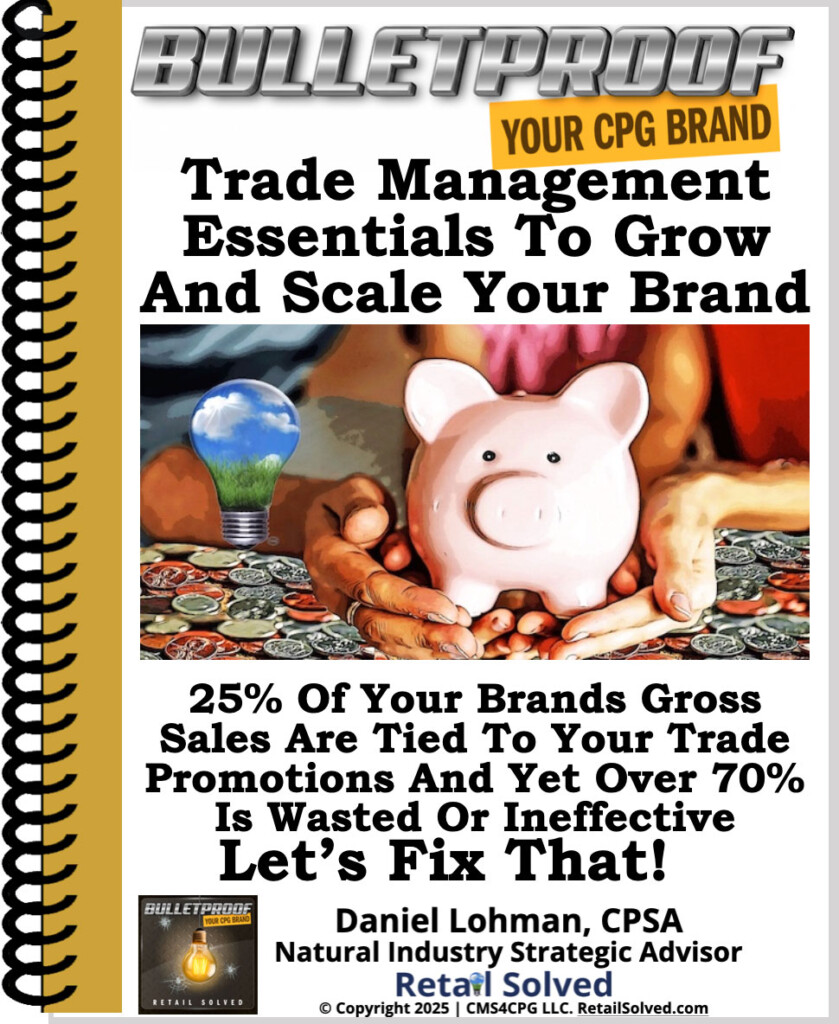
Trade Management Essentials To Grow And Scale Your Brand
Stop Wasting Money! Want To Know How?
Trade marketing includes everything required to get your brand in the hands of shoppers. It’s your growth engine and the largest item on your P&L. Trade marketing is crucial for brand growth, but 70% of trade spending is wasted or ineffective. Learn the essential strategies and tactics to save money and boost profits.
add button
A personal note to all podcast listeners
Hello and thank you for coming to this page.
I am in the process of rebranding.
I competed updating and improving every podcast episode and all are live now.
I am currently working as fast as I can to update and republish all 268 podcast pages on this website.
Making the guide links live are the next thing on my list after that so please keep checking back.
Also, please stay tuned for podcast episode 269 where I will reveal what to expect from the show and what you can expect from me going forward – plus you’ll get to see the new podcast image!
I have a lot go great things planned to help you confidently grow and scale your brand including new episodes, videos, guides, courses, and much much more.
Thanks for your patience. I am working as fast as I can to get everything up an running.
Daniel
Image is the property of CMS4CPG LLC, distribution or reproduction is expressively prohibited.

